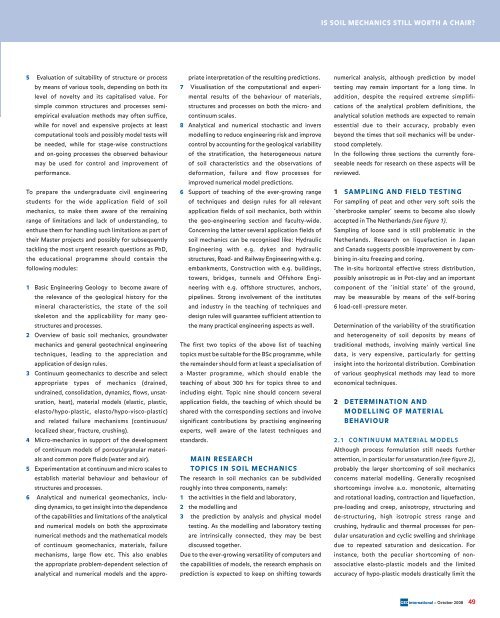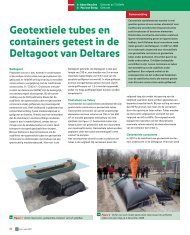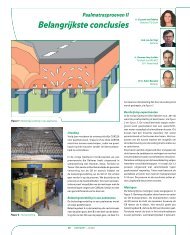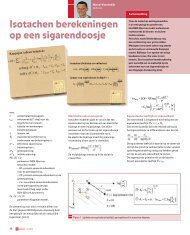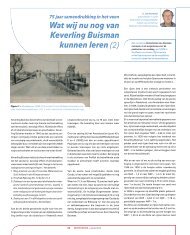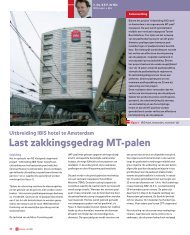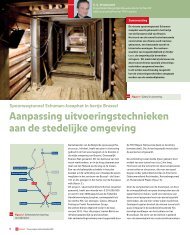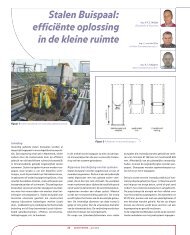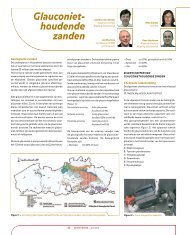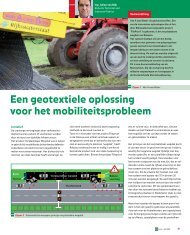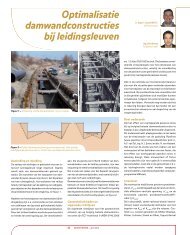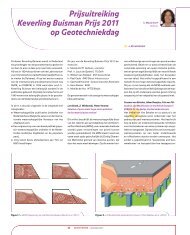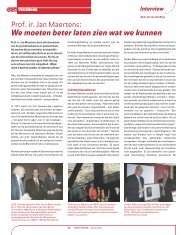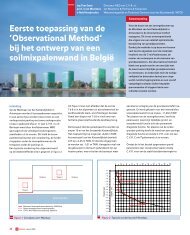i137 GEO binnen - GeoTechniek
i137 GEO binnen - GeoTechniek
i137 GEO binnen - GeoTechniek
You also want an ePaper? Increase the reach of your titles
YUMPU automatically turns print PDFs into web optimized ePapers that Google loves.
5 Evaluation of suitability of structure or process<br />
by means of various tools, depending on both its<br />
level of novelty and its capitalised value. For<br />
simple common structures and processes semiempirical<br />
evaluation methods may often suffice,<br />
while for novel and expensive projects at least<br />
computational tools and possibly model tests will<br />
be needed, while for stage-wise constructions<br />
and on-going processes the observed behaviour<br />
may be used for control and improvement of<br />
performance.<br />
To prepare the undergraduate civil engineering<br />
students for the wide application field of soil<br />
mechanics, to make them aware of the remaining<br />
range of limitations and lack of understanding, to<br />
enthuse them for handling such limitations as part of<br />
their Master projects and possibly for subsequently<br />
tackling the most urgent research questions as PhD,<br />
the educational programme should contain the<br />
following modules:<br />
1 Basic Engineering Geology to become aware of<br />
the relevance of the geological history for the<br />
mineral characteristics, the state of the soil<br />
skeleton and the applicability for many geostructures<br />
and processes.<br />
2 Overview of basic soil mechanics, groundwater<br />
mechanics and general geotechnical engineering<br />
techniques, leading to the appreciation and<br />
application of design rules.<br />
3 Continuum geomechanics to describe and select<br />
appropriate types of mechanics (drained,<br />
4<br />
undrained, consolidation, dynamics, flows, unsaturation,<br />
heat), material models (elastic, plastic,<br />
elasto/hypo-plastic, elasto/hypo-visco-plastic)<br />
and related failure mechanisms (continuous/<br />
localized shear, fracture, crushing).<br />
Micro-mechanics in support of the development<br />
of continuum models of porous/granular materials<br />
and common pore fluids (water and air).<br />
5 Experimentation at continuum and micro scales to<br />
establish material behaviour and behaviour of<br />
structures and processes.<br />
6 Analytical and numerical geomechanics, including<br />
dynamics, to get insight into the dependence<br />
of the capabilities and limitations of the analytical<br />
and numerical models on both the approximate<br />
numerical methods and the mathematical models<br />
of continuum geomechanics, materials, failure<br />
mechanisms, large flow etc. This also enables<br />
the appropriate problem-dependent selection of<br />
analytical and numerical models and the appro-<br />
priate interpretation of the resulting predictions.<br />
7 Visualisation of the computational and experimental<br />
results of the behaviour of materials,<br />
structures and processes on both the micro- and<br />
continuum scales.<br />
8 Analytical and numerical stochastic and invers<br />
modelling to reduce engineering risk and improve<br />
control by accounting for the geological variability<br />
of the stratification, the heterogeneous nature<br />
of soil characteristics and the observations of<br />
deformation, failure and flow processes for<br />
improved numerical model predictions.<br />
6 Support of teaching of the ever-growing range<br />
of techniques and design rules for all relevant<br />
application fields of soil mechanics, both within<br />
the geo-engineering section and faculty-wide.<br />
Concerning the latter several application fields of<br />
soil mechanics can be recognised like: Hydraulic<br />
Engineering with e.g. dykes and hydraulic<br />
structures, Road- and Railway Engineering with e.g.<br />
embankments, Construction with e.g. buildings,<br />
towers, bridges, tunnels and Offshore Engineering<br />
with e.g. offshore structures, anchors,<br />
pipelines. Strong involvement of the institutes<br />
and industry in the teaching of techniques and<br />
design rules will guarantee sufficient attention to<br />
the many practical engineering aspects as well.<br />
The first two topics of the above list of teaching<br />
topics must be suitable for the BSc programme, while<br />
the remainder should form at least a specialisation of<br />
a Master programme, which should enable the<br />
teaching of about 300 hrs for topics three to and<br />
including eight. Topic nine should concern several<br />
application fields, the teaching of which should be<br />
shared with the corresponding sections and involve<br />
significant contributions by practising engineering<br />
experts, well aware of the latest techniques and<br />
standards.<br />
MAIN RESEARCH<br />
TOPICS IN SOIL MECHANICS<br />
The research in soil mechanics can be subdivided<br />
roughly into three components, namely:<br />
1 the activities in the field and laboratory,<br />
2 the modelling and<br />
3 the prediction by analysis and physical model<br />
testing. As the modelling and laboratory testing<br />
are intrinsically connected, they may be best<br />
discussed together.<br />
Due to the ever-growing versatility of computers and<br />
the capabilities of models, the research emphasis on<br />
prediction is expected to keep on shifting towards<br />
IS SOIL MECHANICS STILL WORTH A CHAIR?<br />
numerical analysis, although prediction by model<br />
testing may remain important for a long time. In<br />
addition, despite the required extreme simplifications<br />
of the analytical problem definitions, the<br />
analytical solution methods are expected to remain<br />
essential due to their accuracy, probably even<br />
beyond the times that soil mechanics will be understood<br />
completely.<br />
In the following three sections the currently foreseeable<br />
needs for research on these aspects will be<br />
reviewed.<br />
1 SAMPLING AND FIELD TESTING<br />
For sampling of peat and other very soft soils the<br />
’sherbrooke sampler’ seems to become also slowly<br />
accepted in The Netherlands (see figure 1).<br />
Sampling of loose sand is still problematic in the<br />
Netherlands. Research on liquefaction in Japan<br />
and Canada suggests possible improvement by combining<br />
in-situ freezing and coring.<br />
The in-situ horizontal effective stress distribution,<br />
possibly anisotropic as in Pot-clay and an important<br />
component of the ‘initial state’ of the ground,<br />
may be measurable by means of the self-boring<br />
6 load-cell -pressure meter.<br />
Determination of the variability of the stratification<br />
and heterogeneity of soil deposits by means of<br />
traditional methods, involving mainly vertical line<br />
data, is very expensive, particularly for getting<br />
insight into the horizontal distribution. Combination<br />
of various geophysical methods may lead to more<br />
economical techniques.<br />
2 DETERMINATION AND<br />
MODELLING OF MATERIAL<br />
BEHAVIOUR<br />
2.1 CONTINUUM MATERIAL MODELS<br />
Although process formulation still needs further<br />
attention, in particular for unsaturation (see figure 2),<br />
probably the larger shortcoming of soil mechanics<br />
concerns material modelling. Generally recognised<br />
shortcomings involve a.o. monotonic, alternating<br />
and rotational loading, contraction and liquefaction,<br />
pre-loading and creep, anisotropy, structuring and<br />
de-structuring, high isotropic stress range and<br />
crushing, hydraulic and thermal processes for pendular<br />
unsaturation and cyclic swelling and shrinkage<br />
due to repeated saturation and desiccation. For<br />
instance, both the peculiar shortcoming of nonassociative<br />
elasto-plastic models and the limited<br />
accuracy of hypo-plastic models drastically limit the<br />
<strong>GEO</strong>international – October 2008 49


